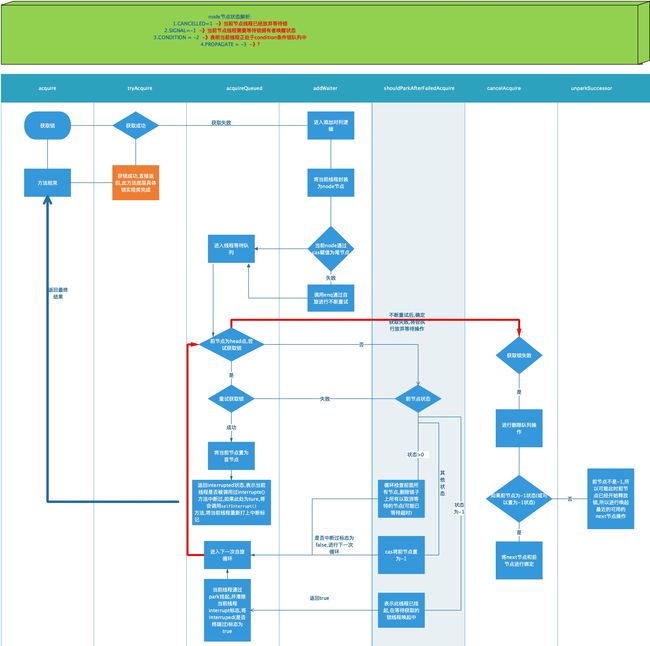目标
分析aqs中顶层方法实现,主要包括方法:
- acquire 外层获取锁方法
- acquireQueued 节点以自旋的方式获取同步状态,如果获取同步状态失败,要挂起线程
- addWaiter 将当前线程包装成node节点添加到等待队列
- shouldParkAfterFailedAcquire 处理当前线程是否应该挂起
- cancelAcquire 对于最终未成功获取到同步锁状态的情况进行移除等待队列处理
主流程时序图
分析下
aqs顶层方法的入口为acquire,看下源码:
public final void acquire(int arg) {
if (!tryAcquire(arg) &&
acquireQueued(addWaiter(Node.EXCLUSIVE), arg))
selfInterrupt();
}
寻着流程图,看到首先调用的tryAcquire方法(但此方法是其具体锁实现类实现的,如我们常用的ReentrantLock类,但此方法我们先略过不管),此方法含义为当前线程去尝试获取资源,当获取失败时调用acquireQueued方法进入等待队列,相当于进入锁池,看下acquireQueued方法:
final boolean acquireQueued(final Node node, int arg) {
boolean failed = true;
try {
boolean interrupted = false;
//1.不断自旋重试或线程等待,直到结果出来
for (;;) {
final Node p = node.predecessor();
//2. 当前节点为头节点,调用tryAcquire尝试获取资源,如果成功直接返回,并把当前节点置为头节点
if (p == head && tryAcquire(arg)) {
setHead(node);
p.next = null; // help GC
failed = false;
return interrupted;
}
//3. 上一步未成功,判断当前阶段是否应该进入线程等待状态,如果线程进入等待,进入等待池.
if (shouldParkAfterFailedAcquire(p, node) &&
parkAndCheckInterrupt())
//4. 等待被唤醒后标注此线程被中断过
interrupted = true;
}
} finally {
if (failed)
//5. 不断试验后获取锁失败,进行放弃等待逻辑,将此节点从队列中移除
cancelAcquire(node);
}
}
看下shouldParkAfterFailedAcquire方法,什么情况下满足线程等待:
private static boolean shouldParkAfterFailedAcquire(Node pred, Node node) {
int ws = pred.waitStatus;
//1. 前节点状态为Node.SIGNAL,代表此节点已经标记,当他资源释放后,唤起后面的节点,所以本节点可以安全park
if (ws == Node.SIGNAL)
/*
* This node has already set status asking a release
* to signal it, so it can safely park.
*/
return true;
if (ws > 0) {
//2. 当状态>0,表述前节点已经放弃等待,所以递归前移,找到可用节点
/*
* Predecessor was cancelled. Skip over predecessors and
* indicate retry.
*/
do {
node.prev = pred = pred.prev;
} while (pred.waitStatus > 0);
pred.next = node;
} else {
/*
* waitStatus must be 0 or PROPAGATE. Indicate that we
* need a signal, but don't park yet. Caller will need to
* retry to make sure it cannot acquire before parking.
*/
//3. 其他情况,cas尝试将前节点状态设置为Node.SIGNAL状态,表示前节点结束后唤醒当前节点,但本次并不阻塞.
compareAndSetWaitStatus(pred, ws, Node.SIGNAL);
}
return false;
}
上面就是尝试获取队列,失败进行阻塞的逻辑.其中还有个addWaiter(Node.EXCLUSIVE)方法,此方法用于将当前线程包装成一个Node,并放入队列中:
private Node addWaiter(Node mode) {
Node node = new Node(Thread.currentThread(), mode);
// Try the fast path of enq; backup to full enq on failure
Node pred = tail;
if (pred != null) {
node.prev = pred;
// 1. 尝试将当前节点设为尾节点,成功后,返回此节点
if (compareAndSetTail(pred, node)) {
pred.next = node;
return node;
}
}
//2. 如果设置失败,此方法进行不断自旋(不断循环到原有逻辑进行重试),尝试加入尾几点
enq(node);
return node;
}
对应自旋逻辑 enq(node);
private Node enq(final Node node) {
//不断循环自旋重试
for (;;) {
Node t = tail;
if (t == null) { // Must initialize
//当队列为空时,必须有个首节点,进行初始化
if (compareAndSetHead(new Node()))
tail = head;
} else {
node.prev = t;
//尝试再次设置尾节点,失败后将会循环重试,成功将返回此节点
if (compareAndSetTail(t, node)) {
t.next = node;
return t;
}
}
}
}
好了,上面就是顶层aqs抽象类定义的方法.
引申出tryAcquire方法:
tryAcquire方法在顶层并未实现,具体实现是各个具体锁实现的,如ReentrantLock中通过两个内部类NonfairSync(非公平锁)和FairSync(公平锁)来实现,下面对比下这两个类的此方法:
1. 公平锁获取方法
protected final boolean tryAcquire(int acquires) {
final Thread current = Thread.currentThread();
//1. 获取当前资源状态
int c = getState();
if (c == 0) {
//2.通过hasQueuedPredecessors方法判断是否有其他线程排在前边等待队列
if (!hasQueuedPredecessors() &&
//3. 如果当前此线程排在最前边,则将当前队列状态值赋值, acquires在独占锁中一直是1,所以就是0到1点变化
compareAndSetState(0, acquires)) {
//4.如果状态修改成功,则将当前资源拥有者改成当前线程,返回true
setExclusiveOwnerThread(current);
return true;
}
}
//5. 上一步判断c!=0代表已有线程拥有资源,判断当前线程是否为此线程
else if (current == getExclusiveOwnerThread()) {
//6.如果是当前线程获取的资源,此处重新获取锁,因为为可重入锁,所以锁次数加1
int nextc = c + acquires;
if (nextc < 0)
throw new Error("Maximum lock count exceeded");
setState(nextc);
return true;
}
return false;
}
上面的分析,看出了公平锁的实现,其中还有个重点,hasQueuedPredecessors方法是怎么判断是否有其他队列排在前边:
public final boolean hasQueuedPredecessors() {
// The correctness of this depends on head being initialized
// before tail and on head.next being accurate if the current
// thread is first in queue.
Node t = tail; // Read fields in reverse initialization order
Node h = head;
Node s;
//1. 此方法需要返回false才代表没有排在前边的线程等待
//2. 如果h!=t表示等待队列有其他节点存在,否则h==t表示只有一个节点,直接返回false,表示当前线程可以获取资源
//3. 如果h!=t,则表示队列中有线程在使用资源,继续判断(s = h.next) == null表示第二个节点为null,说明h的下一个节点异常,可能是在其他线程处理线程队列过程中,直接返回true
//4.最后一个判断s.thread != Thread.currentThread(),在上面所有可能后,判断s线程不是当前线程,则说明已有其他线程索取到锁了
return h != t &&
((s = h.next) == null || s.thread != Thread.currentThread());
}
2. 好了,公平锁完了,下面看下非公平锁怎么实现:
final boolean nonfairTryAcquire(int acquires) {
final Thread current = Thread.currentThread();
int c = getState();
if (c == 0) {
//.非公平锁,不用判断队列中是否有其他节点,直接尝试修改资源状态,如果成功,代表获取到资源,直接返回
if (compareAndSetState(0, acquires)) {
setExclusiveOwnerThread(current);
return true;
}
}
else if (current == getExclusiveOwnerThread()) {
int nextc = c + acquires;
if (nextc < 0) // overflow
throw new Error("Maximum lock count exceeded");
setState(nextc);
return true;
}
return false;
}
我们现在非公平锁实现和公平锁逻辑类似,只是少了一个hasQueuedPredecessors方法,不在去判断是否前面有线程排队而已.
引申出参数(int acquires)
在独占锁中, acquires一直为1,表示占有锁到永远只有一个,看下ReentrantLock的写法:
public boolean tryLock() {
return sync.nonfairTryAcquire(1);
}
而在CountDownLatch等共享锁到实现中,此值也是1,但其实现类中,通过构造器添加共享锁中的资源可用数.
public CountDownLatch(int count) {
if (count < 0) throw new IllegalArgumentException("count < 0");
this.sync = new Sync(count);
}
...........................................
//初始设值,选择共享锁容量
private static final class Sync extends AbstractQueuedSynchronizer {
private static final long serialVersionUID = 4982264981922014374L;
Sync(int count) {
setState(count);
}
int getCount() {
return getState();
}
protected int tryAcquireShared(int acquires) {
return (getState() == 0) ? 1 : -1;
}
好了,上面就分析完了aqs实现的重点逻辑.
AQS研究系列(一)--Unsafe使用
AQS研究系列(二)--线程状态和interrupt()、interrupted()、isInterrupted等方法学习
